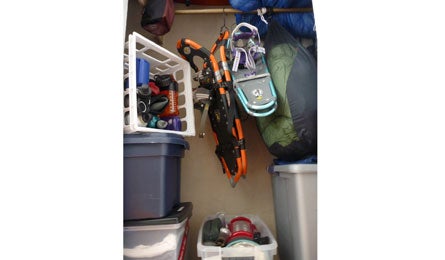Prof. Hike: Make Your Gear Last Longer

' Use stackable plastic tubs and closet rods to store gear in tight spaces. (Jason Stevenson) '
How much does a new backpacking stove cost? Try $90 to $150. What about replacing your leather hiking boots? Plan to spend at least $130. Want to find a good rain shell for under $100? Good luck.
Triple-digit prices are the norm for outdoor gear—even for soft shells and rain paints. You can easily plunk down $400 while shopping at a local outdoor store, or filling an online shopping cart at REI.com. So what can a thrifty hiker do?
First, you might notice that Walmart sells a four-person Ozark Trail backpacking tent for $33. But before you buy it, you should read the online review that describes how the tent collapsed in the middle of the night during a minor rainstorm. Is cost more important than safety? Walmart can sell me stove fuel and bacon, but not much else.
Second, you can reminisce about the good ‘ol days when external frame packs ruled the trail, polyester ruled the disco floor, and camping gear cost pennies. But inflation makes those low prices as illusory as Walmart’s quality. Back in in 1973 (the year Backpacker magazine debuted), the average nation wage index was $7,580, compared to $40,711 in 2009. By the same ratio, the $300 you spent to buy a backpack today would be worth the same as $55 in 1973. That seventies-era backpack might seem cheap compared to today’s prices, but it wasn’t for your seventies-era hiker.
Third, you can purchase expensive but well-made outdoor gear, and then devote the time and energy to make it last as long as possible. Compared to cutting corners on safety by shopping at big-box stores, or wishing for the return of the gold standard, I think this third option makes the most sense. Plus, the process of cleaning and maintaining your gear will make you a more skilled hiker.
Below are 11 steps you can take to prolong the lifespan of your valuable outdoor gear. Don’t wait until your next trip to make these changes—grab this list and go to your gear closet now.
Do this: Store uncompressed sleeping bags in breathable cotton, mesh, or canvas stuff sacks placed on shelves or hung from a towel rod.
Why: Compressing bags crushes down feathers and breaks synthetic fibers, reducing their ability to trap air, maintain loft, and keep you warmer on cold nights.
Do this: Keep compressed sleeping bags away from hot and/or humid spaces—like an attic or the trunk of a car.
Why: Prolonged compression combined with heat and humidity will reduce the lifespan of a bag even faster than each alone.
Do this: Hang sleeping bags and tents to dry inside-out after every trip.
Why: Eliminating interior moisture will reduce the growth of mildew during storage.
Do this: Uncap water bottles and hydration bladders when not in use.
Why: Continuous air flow prevents moisture from being trapped inside.
Do this: Store hydration bladders and tubes in your refrigerator.
Why: Frigid air slows down the mold that naturally grows in hard-to-clean spaces of the bladders and tubes.
Do this: Wash hiking shoes and boots with lukewarm water and a vegetable brush to remove mud and organics after each trip. Let them dry completely before storing in a closet.
Why: Mud and plants contain acids and alkalines that can damage leather, rubber, and fabric after prolonged exposure.
Do this: Store battery-powered devices and extra batteries in cool, dry locations
Why: Excessive heat (more than cold) drains unused batteries.
Do this: Wipe-down gas stoves to remove carbon deposits and food stains with a sponge soaked in lukewarm water and dish soap after each trip.
Why: Not only to carbon stains look bad, but they can eventually clog the fuel lines and burner pores, causing a stove to sputter.
Do this: Store stove fuel and pressurized canisters in a garage, basement, or shed separate from the rest of you gear.
Why: Reduce the risk of leakage, fire, and explosion.
Do this: Double-plastic bag insect repellants, especially DEET-based products, to prevent leakage
Why: DEET eats through nylon, polyester, and waterproof linings like a hungry grizzly clawing through a beehive.
Do this: Apply durable water repellant (DWR) treatments to waterproof apparel at the start of each hiking season. Try Nikwax TX.Direct spray-on or wash-in.
Why: DWR coatings naturally degrade in sunlight and after frequent use. Signs of reduced DWR performance include condensation build-up, reduced beading of water droplets, and fabric saturation after light rains.
How do you increase the lifespan of your favorite gear? Or, what item have you kept functional for years or even decades? Post a comment or send an email to profhike@backpacker.com.
—Jason Stevenson